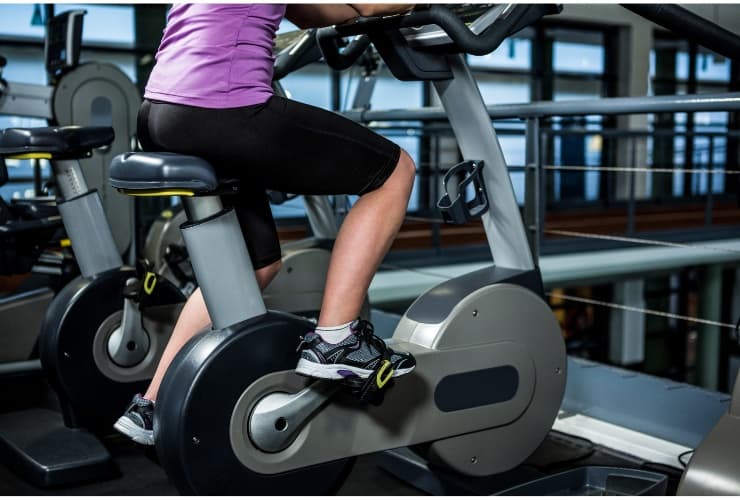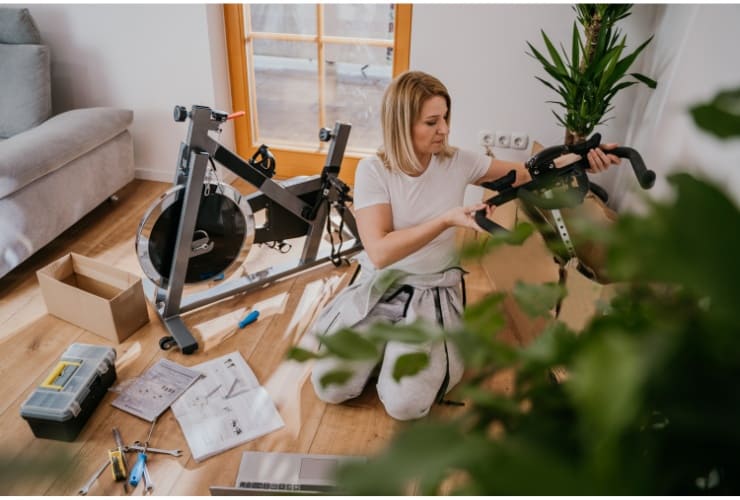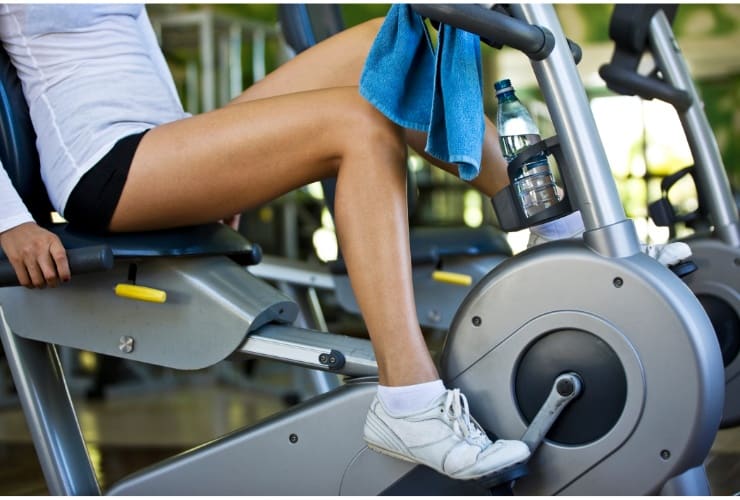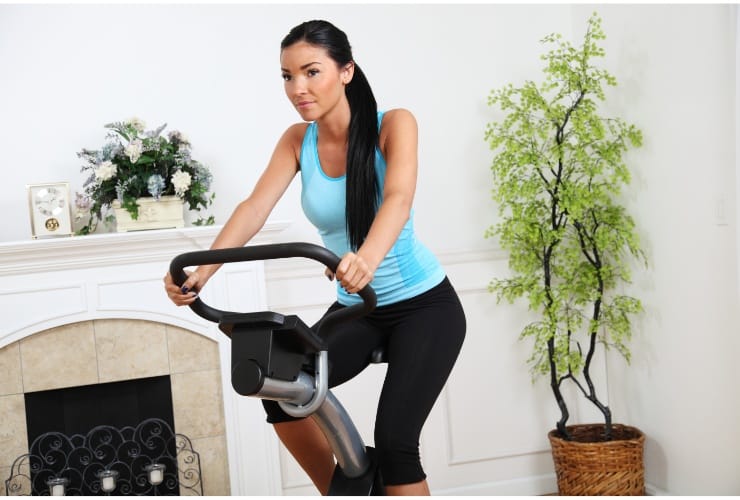Let’s face it, one of the main drawbacks to cycling is the occasional screeching noise that can grind your gears. Not only are those squeaks and creaks annoying and distracting, they also can be indicators of a greater problem with your bike.
It’s no secret that any exercise machine will eventually need some proper maintenance.
Unfortunately, squeaking is a common problem that affects almost all cyclists at some point. In this article, we will explore the causes for those pesky squeaks and equip you with solutions suited to the origin of the squeaking.
Key Takeaways
- Squeaking and rattling noises from your exercise bike can be caused by various factors–loose bolts, dried out brakes, worn out belt, or dirty parts.
- You can fix most of the noises by applying lubricant oil, silicone spray, or grease paste to the affected parts, like the spin belt, brake pads, seat post, or crankset.
- You can also tighten the bolts and screws on your bike with a torque wrench or a hex wrench to reduce the movement and friction of the handlebars, seat, bottle cage, or stem.
- You can prevent noises in the future by getting your bike serviced annually by a qualified bike mechanic and bringing some lube with you while riding.
- If none of the above solutions work or you are not confident in doing them yourself, you can always take your bike to a bike repair shop for professional help.
Why is My Bike Squeaking?
Below, we will explain the most common causes of a squeaking exercise bike. Likely, the noises are due to a combination of loose bolts in one or more of the apparatuses or dried out brakes. If you’re on a stationary bike, another cause could be a dried out belt.
Creaky Handlebars
Handlebars that have looseness in their stem bolts can lead to creaky and squeaky noises. Tightening your stem bolts with a hex wrench will ameliorate this problem.
Creaky Bike Stem
The stem, the part of your bike connecting handlebars to the steering tube, also has tons of bolts. This interface can also be a host to lots of dirt and debris, and as you turn the handlebars the friction can cause unpleasant sounds.
Squeaky Brakes
With repeated use, the fibers of your brake pads tend to wear off. They also can dry out, which leads to the awful squeaking noise.
If your wheels are correctly working, the sound may be due to dirty brake pads vibrating in the front wheel of your vehicle. Cleaning the brake surfaces from the tire and applying silicone sprays is recommended. If the cleaning fails to resolve your vibration, you can replace your brakes if they are worn. We will explore this in more depth in the next section.
Wobbly Seat

If you´re noticing squeaky noises coming from your seat, it’s likely that the clamp attaching to the rails is loose. The friction from the seat rubbing against the rail is causing the noise. This can be rectified by tightening bolts to reduce the movement of the saddle.
Squeaky Bike Seat Post
Sometimes, the creaking sounds are originating from the seat post instead of your seat. Your seat post is the piece of metal that your seat is attached to, which stems from the base of your bike. In this case, you may need to remove the seat and seat post to apply lubricant.
Loose Bottle Cage
Any variety of bike is home to many different kinds of bolts, which are the cause of a rattling noise when cycling. If on a stationary bike, turn your music off and try to determine the precise location of the rattling when riding.
A loose bottle cage (the apparatus that affixes your water bottle to the bike) is a likely culprit of rattling, so check and see if that is securely fixed.
Squeaky Spin Bike Belt
Most home exercise bikes have a spin belt (as opposed to a bike chain) that keeps your pedals moving. Usually the spin belt is completely silent, however with time it can dry out and scratch against the wheel it rubs up against.
Creaky Crankset
Your bike’s crankset is the set of sprockets (also known as chainrings or chainwheels), cranks, and crank arms connected to the pedals. This means that creaking in the pedal zone could come from the cranks, bottom bracket, or screw threads.
How do I Stop my Exercise Bike from Squeaking?

There are a few things you can do to stop your exercise bike squeaking, but these steps obviously depend on where the squeaking is coming from. Let’s take a look at some basic fixes that can help in the most common scenarios.
Use Lubricant Oil
Using lubricant oil on various parts of your bike will eliminate the squeaking noise by easing the friction between the apparatuses causing the noises. Below are specific parts that could benefit from lubricant:
Lubricate the Spin Belt
Spin belts can get dried out from dryness or simply from lots of use. To ease those pesky squeaks, spray your belt with silicone spray for only one second. If it is still squeaking, the next best step is to tighten the belt slightly.
If none of the above remedies are ameliorating the squeaks, you can always order a new bike if you are certain the culprit of the squeaking is your belt.
Apply Lubricant to the Seat Post
Creaks from your seat post can be easily quelled by adding a light coat of bike lubricant to the seat collar. Remove the seat by loosening the bolt, take a rag to remove previous grease and dirt, and apply the lubricant.
Note: if your seat post is made of carbon, not aluminum, use a carbon fiber paste instead of classic grease lube.
Use Lubricant on the Brakes
Because the squeaking noise is likely due to a brake pad being dried out and frayed, simple silicone spray will do the trick.
Take the brake pads off and saturate each pad with the lubricant. It´s a good idea to do this regularly to your brake pads to avoid the squeaking in the future. This is a safe fix – many bike engineers recommend it.
If you’re still without luck, ordering a new pair of replacement pads is your best option.

Check the Joints, Screws and Bolts
As you probably know, bikes are equipped with numerous bolts, screws and joints that are bound to work loose and cause rattling noise at some point. A loose bottle cage is a likely cause if you’re hearing a loud rattling noise.
Other common locations for loose bolts are the pedals, bike stem, crankset, seat, and handlebars, all mentioned above.
According to professionals, a torque wrench is the proper tool to use to ensure all the bolts are tightened to manufacturer specifications. The proper bolt tightness is usually noted right next to the bolt in question, on your rotor or your stem.
Disassemble the Stem
As mentioned above, many times the culprit of squeaking is the bolts in the bike stem. To fix this, disassemble the interface of your stem, faceplate and bars, wash all the parts with degreaser.
Once you’ve accomplished this, coat the bolts with grease or lubricant and reassemble. Be sure to use a torque wrench rather than an allen wrench in this case.
Squeaking from Pedals: Tighten or Replace The Bike Crank

The crank is the part of your bike that your chain rings are bolted onto. Whether your pedals have some years on them, or recently swapped out, it’s likely the cranks are loose if you’re hearing screeching sounds when you pedal. Each pedal is attached with a crank arm.
Your first order of business is to check that each crank arm is tight. If not, tighten them by removing the pedals with a flat head screwdriver.
Secondly, some silicone spray brushed over your pedals can do the trick. Be sure not to brush your brakes or brake pads.
If this still doesn’t solve the squeaking, you may need to replace the crank arm on each side. You’ll need a socket wrench or torque wrench and a crank puller to do so, which you can find at well stocked bike shops.
In order to replace the old crank arm, take off the bolt on the arm with a socket wrench, and thread the crank puller onto the threads located in the crank arm. You can now put the pedal back on.
Be sure that the corresponding crank arms are opposing each other. This means that if the left crank arm is down, the right crank arm should be up.
Place Your Bike on a Mat or Carpet
If you’re struggling with a stationary bike’s noises, placing it on a hard surface can create annoying noises from the friction of the machine. Station your exercise bike on a soft mat or carpet to ensure it stays firmly in place.
Adjust The Seat
It’s easy to tell if the sounds are coming from your bike seat – listen closely for noises as you move around on your saddle. Luckily, this warrants a quick fix. Tighten the screws on your seat as tight as possible with a wrench.
Also note that it’s crucial all of the nuts are tightened evenly. If they are not evenly secured, the seat may be at an angle or swivel. To see if this is the case, the bolts will show unevenly (they would all be evenly exposed if they are correctly secured).
Also, the seat clamp should be fully flush to the seat post. If not, it’s not fully secure even if the nuts are as tight as possible. The v-shaped tab on your clamp should be all the way down so that the top of your saddle touches the tab.
Visit Your Local Bike Repair Shop
If none of the above options are viable or you are feeling unprepared to tackle some advanced maintenance, your best bet is to bring your exercise bike to a bike repair shop. Establishing rapport with a local shop is always prudent and will yield great customer service each time.
The Bottom Line
Squeaky and rattling noises coming from your exercise bike are certainly irritating, but can be rectified with some basic maintenance. Simple adjustments such as securing your seat, lubricating your belt or brakes, or tightening your bottle cage and bike crank are likely to ease the noise. There are some straightforward things you can do to prevent noises in the future:
- Get your bike serviced annually by a qualified bike mechanic
- Always keep your bike clean and lubricated
- Bring a tube of paste grease and liquid lube with you while riding
- Keep a torque wrench and spare bolts around your house
We hope this article leaves you equipped with the knowledge to tackle those squeaks and rattles. Was this article helpful? Let us know what you think below in the comments.

